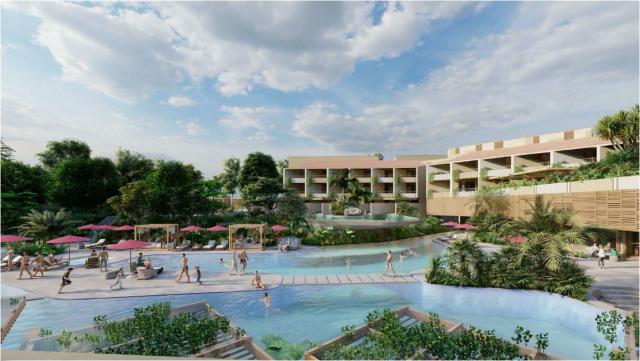Noosa councillors said no to a development application for a $50m, 106-room hotel at Noosa Springs in a motion unanimously supported on Monday.
They will await legal advice before making a final decision on the application at their ordinary meeting on Thursday night.
Inconsistencies with the Noosa Plan 2020 that included the clearing of vegetation in a known koala and glossy black cockatoo habitat, inconsistent zoning, noise concerns and odour concerns, being only 200m from a sewerage treatment plant (STP), were among the reasons given for the refusal.
The application, an initiative of GH Australia, the Australian arm of Hong Kong property and development firm, Golden Horse Group and owner of Noosa Springs Golf and Spa Resort, proposes the construction of a five-star hotel spanning five two and three storied buildings and featuring a two-level lagoon style swimming pool.
Last week deputations were put to council by architect and Noosa Springs resident John Cochrane opposing the development, Unitywater’s Rhett Duncan who warned of the odour impact from the nearby sewerage treatment plant and urged council not to approve the development application, and the developer’s representative Ellen Guan.
Councillors questioned council officers on concerns over the application for more than 90 minutes at Monday’s general meeting before Cr Brian Stockwell put forward the motion to refuse the application for a range of reasons he explains himself on P3, and the other councillors agreed.
Cr Amelia Lorentson raised concerns made by Unitywater about the potential of odour complaints to result in investigations by the regulator and the consequential requirement to install expensive odour controlling modifications that would cost tens of millions of dollars and be borne by rate payers.
Using a measure of odour that puts level one at being where an odour can just be detected, the hotel was proposed for construction just outside a 2.5 odour line, being 2.5 times the level at which an odour can be just detected, officers explained.
To reduce the impact of odour, development conditions included the hotel be fully air-conditioned with odour-absorbing carbon filters used and time restrictions be placed on the use of outdoor areas to avoid night times when odour levels may be higher.
Officers said there was the potential for complaints but the need for STP modification would depend on the substantiation of complaints on investigation.
When asked about reputational risk in relation to odour complaints, the officer said there was less chance of hotel guests complaining to the regulator than permanent residents.
“You don’t have to tell people there’s a sewerage treatment plant there. In terms of reputational risk if the odour levels at 2.5 or below that, they shouldn’t take offence. It’s not a high level of odour. It might be something you’ll smell on occasion,” the officer said.
In response to Cr Frank Wilkie’s questions about the potential for noise concerns from nearby residents from traffic and service trucks in the loading area officers said an updated acoustic report was required but there shouldn’t be that high a volume of traffic.
Cr Amelia Lorentson questioned the proposed bushfire evacuation plan in the area containing about 700 properties with a one-street entrance and exit.
Officers said there were two emergency exits which could be accessed in emergencies with the opening of a gate and safe assembly areas at the country club in the first instance, then on the golf course.
“In a prolonged incident people can’t stay on the golf course,” Cr Joe Jurisevic said.
Officers were unable to provide an indication of the number of vehicles that would need to evacuate the area in an emergency by guests, residents, spa guests, visitors and residents.
Council officers recommended the development application be approved, subject to conditions, on the site which is zoned partly for Tourist Accommodation and partly for Recreation and Open Space.
In their report, officers said documentation on odour impacts had been assessed and reviewed and “supported by Council’s consulting odour expert with conditions recommended to address use of outdoor areas and ventilation of the building at its interface with the accepted odour limit.
“The application has also demonstrated compliance with the car parking, bushfire, and water quality/quantity requirements of the Noosa Plan whilst variations to setbacks associated with the two-level car park and elevated tennis courts are supported,” the report stated.








